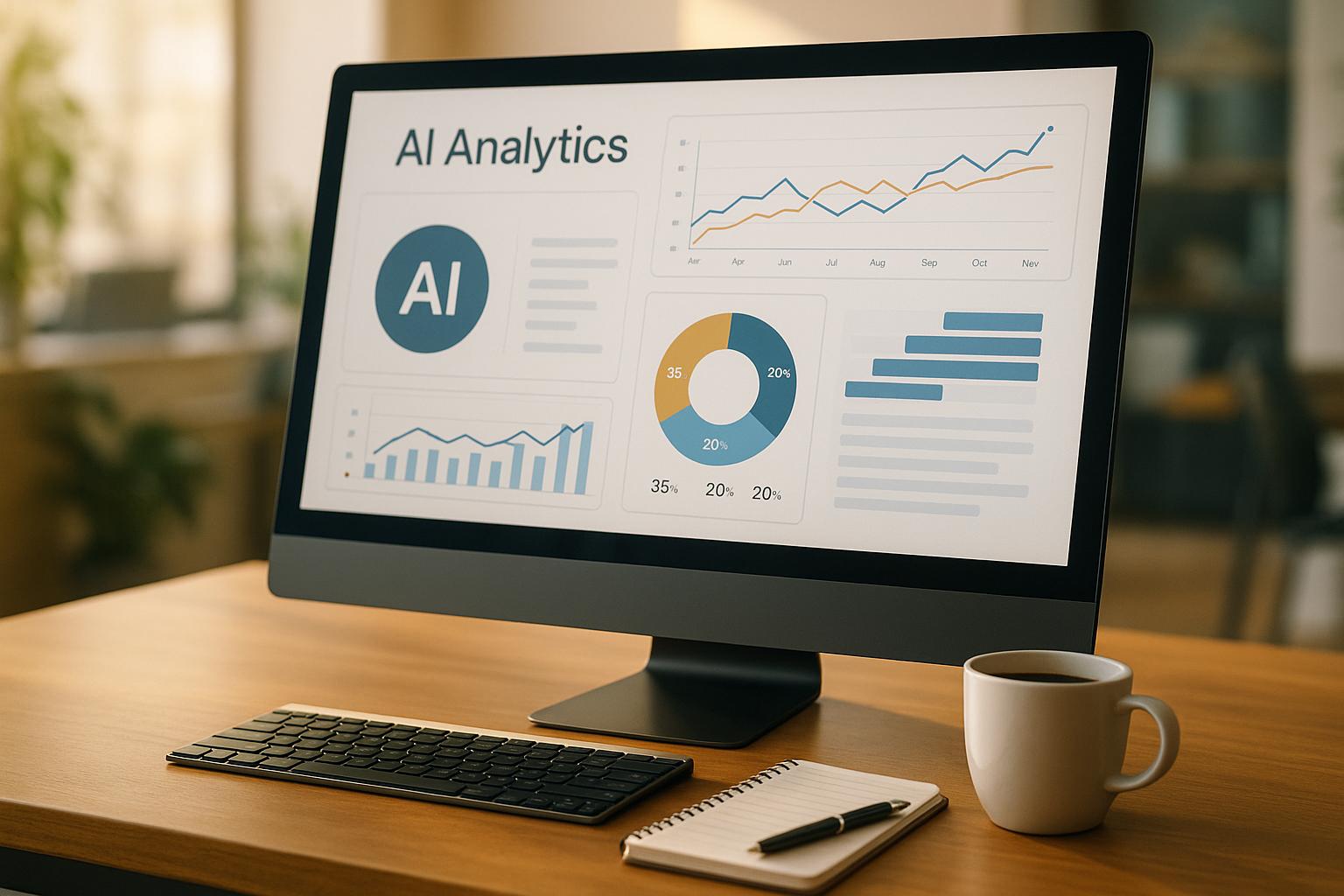AI tools are transforming how businesses handle cross-border data security compliance. Managing data across regions is challenging due to complex regulations like GDPR, CCPA, and HIPAA. Here's how AI simplifies compliance:
- Automated Risk Detection: Instantly flags potential violations.
- Document Analysis: Processes legal documents quickly.
- 24/7 Security Monitoring: Detects breaches and unusual patterns in real time.
- Synthetic Data Generation: Creates test data to protect sensitive information.
- Compliance Tracking: Monitors data flows and generates reports.
Quick Overview of AI Benefits:
| Challenge | AI Solution | Impact |
|---|---|---|
| Data transfer restrictions | Compliance mapping | Simplifies multi-region compliance |
| Breach detection | Real-time alerts | Faster response to threats |
| Audit and record-keeping | Automated logs and reports | Reduces manual work |
| Security monitoring | Behavioral analysis | Identifies risks proactively |
AI tools save time, reduce errors, and ensure businesses stay compliant with evolving regulations. Start by assessing your current compliance gaps, choosing the right AI tools, and integrating them into your systems.
Leveraging AI for Automated Data Governance & Compliance ...
Main Data Compliance Challenges
Managing cross-border data compliance is a complex task for businesses operating internationally. These issues require effective solutions, often aided by AI-driven tools.
Data Location Rules and Limits
Regulations like GDPR and China's Cybersecurity Law impose strict requirements on data transfers and storage. GDPR restricts personal data transfers outside the EU unless adequate protections are ensured, while China's Cybersecurity Law requires certain data types to remain stored locally.
Key challenges include:
- Data Transfer Mechanisms: Ensuring legal methods are in place for transferring data across borders.
- Server Location Management: Setting up and maintaining servers in required jurisdictions.
- Tracking Data Storage: Monitoring and documenting where data is stored.
Next, let’s look at how constant monitoring supports these requirements.
24/7 Security Monitoring
Continuous security monitoring is critical for maintaining compliance. Around-the-clock surveillance helps detect breaches and respond to incidents swiftly.
| Monitoring Task | Challenges |
|---|---|
| Real-time Access Tracking | Handling large volumes of access logs across time zones |
| Breach Detection | Filtering real threats from daily alerts |
| Response Documentation | Keeping detailed records for multiple jurisdictions |
| System Updates | Ensuring timely security patches across global systems |
After addressing these monitoring challenges, strong audit and record-keeping practices become the next cornerstone of compliance.
Audit and Record-Keeping Rules
Audits are essential for ensuring compliance in cross-border data management. Accurate and thorough documentation is key to demonstrating adherence to regulations.
Organizations need to focus on:
- Audit Trails: Recording data access, modifications, and system changes.
- Access Logs: Tracking who accessed data, when, and from where.
- Change Management: Documenting updates to security protocols and systems.
- Compliance Reports: Producing reports that align with various regulatory demands.
Regulations often have different record retention requirements, making it necessary to manage multiple schedules. Manual processes can't keep up with the scale and complexity of global data flows.
AI Solutions for Data Security Compliance
AI tools simplify the challenges of managing cross-border data security compliance. They help organizations automate complex processes, reduce errors, and save resources.
AI Compliance Tracking Tools
AI tracking tools are designed to navigate the intricate compliance landscape by automatically monitoring data flows and ensuring compliance across regions. Their core features include:
- Real-time detection of policy and security breaches
- Automated compliance reporting to streamline audits
- Document analysis and classification for better organization
- Tracking regulatory requirements across multiple jurisdictions
For example, when dealing with regulations like GDPR, AI systems can flag unauthorized data transfers or identify privacy risks before they escalate into major compliance issues. This proactive approach ensures smoother operations across borders.
AI Data Risk Analysis
AI-powered tools continuously evaluate data security vulnerabilities, offering insights into potential risks in global operations. These tools can:
- Spot patterns in sensitive data
- Assess compliance risks by region
- Suggest actionable risk mitigation strategies
Additionally, they generate synthetic data for testing, preserving the integrity of actual datasets.
| Risk Analysis Function | AI Capability | Business Impact |
|---|---|---|
| Data Classification | Detects sensitive data automatically | Speeds up review processes |
| Risk Scoring | Assesses risk levels in real time | Enables faster decision-making |
| Threat Detection | Identifies anomalies using patterns | Boosts detection accuracy |
| Compliance Mapping | Tracks multi-regulation requirements | Simplifies global compliance efforts |
These capabilities ensure businesses stay ahead of potential vulnerabilities.
AI Security Monitoring
AI-powered security monitoring provides constant oversight, offering instant threat awareness across international operations. Key benefits include:
- Behavioral analysis of data access
- Automated threat detection for faster responses
- Real-time security alerts to address issues immediately
- Monitoring cross-border data flows to ensure compliance
These systems excel at spotting unusual patterns that could signal security breaches or compliance violations. They also adapt to new threats and changing regulations, making them a strong ally for businesses operating in multiple regions.
To maximize the benefits, integrate AI tools into your existing systems, maintain clear audit trails, and update regularly to stay compliant with evolving regulations. For businesses - especially SMEs and growing companies - interested in exploring AI tools, visit AI for Businesses for a curated selection designed to improve efficiency and compliance.
sbb-itb-bec6a7e
Adding AI Tools to Current Systems
Compliance Needs Analysis
Assessing your data compliance requirements thoroughly is the first step in identifying where AI tools can improve processes. Focus on these areas:
| Assessment Area | Key Considerations | Expected Outcome |
|---|---|---|
| Data Flow Mapping | Cross-border transfer points, storage sites | Clear view of areas needing upgrades |
| Risk Assessment | Current security measures, vulnerabilities | Prioritized compliance focus |
| Resource Analysis | Staff skills, tech infrastructure | Evaluation of readiness for implementation |
| Compliance Gaps | Current vs. required security measures | Defined needs for AI tools |
Document these findings to create a detailed roadmap for compliance improvements.
Selecting AI Compliance Tools
Pick tools that address your identified gaps. Look for features such as:
- Seamless integration with current systems
- Scalability to handle business growth
- Jurisdiction-wide compliance coverage
- User-friendly interfaces for quicker adoption
- Automatic regulatory updates to stay current
For example, AI for Businesses offers curated compliance tools tailored to specific needs. Their Pro plan includes advanced compliance solutions and priority support during setup.
Once you've chosen the tools, integrate them methodically into your operations.
Tool Setup and Growth
Adding AI tools to your systems ensures compliance across different regions. Here's how to integrate them effectively:
1. Initial Testing Phase
- Use representative data to test functionality
- Confirm security measures are effective
- Test integration and performance
- Document all results for future reference
2. Staff Training Program
- Train staff on tool usage and features
- Cover compliance procedures and security protocols
- Include emergency response guidelines
3. System Integration
- Start with non-critical systems to minimize risks
- Gradually extend to core operations
- Monitor performance closely
- Keep detailed records of integration steps
4. Performance Monitoring
- Track how well the system detects compliance issues
- Measure response times for alerts
- Evaluate overall system accuracy
- Assess how well staff are adopting the tools
Future of AI in Data Compliance
As AI tools become more integrated into business operations, companies must prepare for the changing landscape of data regulations. Staying ahead means regularly reviewing and updating compliance strategies to align with new rules. By leveraging today's AI tools to streamline compliance, businesses can better position themselves to tackle future challenges.
Emerging AI Data Rules
Regulations around AI and data are constantly evolving, and businesses need to ensure their tools keep up. Depending on the jurisdiction, rules can vary, but one thing is clear: companies must evaluate how their AI systems handle and protect data, especially during cross-border transfers. Updating AI tools to meet these changing requirements is essential. Additionally, ensuring these systems remain unbiased will be a key focus as regulations continue to take shape.
Reducing AI Bias
To maintain ethical practices and build trust, companies must address bias in AI systems. Here are some ways to achieve this:
- Regularly review AI decision-making processes
- Use diverse and representative training data
- Include human oversight to verify AI outcomes
- Document decision-making protocols clearly
These actions promote transparency and fairness in AI-driven compliance systems, helping businesses align with ethical standards while managing data securely.
Evolving Global Standards
As global data security standards shift, businesses must stay prepared by:
- Implementing AI tools that can adapt to both current and future regulations
- Ensuring compliance strategies keep pace with changing legal and ethical expectations
Wrapping It All Up
As managing cross-border data security becomes more demanding, AI tools are stepping in to help small and medium-sized businesses (SMEs) stay compliant while simplifying their processes. These tools are changing the way businesses approach data security, making it easier to manage compliance effectively.
Key Takeaways for Business Leaders
AI-driven compliance tools take care of tasks like risk analysis and ongoing monitoring, reducing manual effort. Here's what to keep in mind:
- Evaluate your compliance needs thoroughly before adopting any tool.
- Look for solutions that work seamlessly with your current security systems.
- Keep your tools updated to stay in line with evolving regulations.
These steps lay the groundwork for integrating AI tools into your compliance strategy.
How to Get Started with AI Tools
To make the most of AI in compliance, begin by assessing where you stand and what you need:
-
Review Your Current Compliance Framework
Take a close look at your existing data security measures. Identify any gaps where AI tools could provide immediate support. -
Choose the Right AI Tools
Select tools that align with your compliance goals and can grow with your business. Consider factors like:- Compatibility with your systems
- Ability to scale as your needs grow
- Adherence to regional data protection laws
- Overall cost and value
-
Implement and Track Progress
Set clear performance metrics to evaluate how well the tools are working. Regularly monitor their effectiveness and make adjustments as needed to keep up with your business's evolution.


